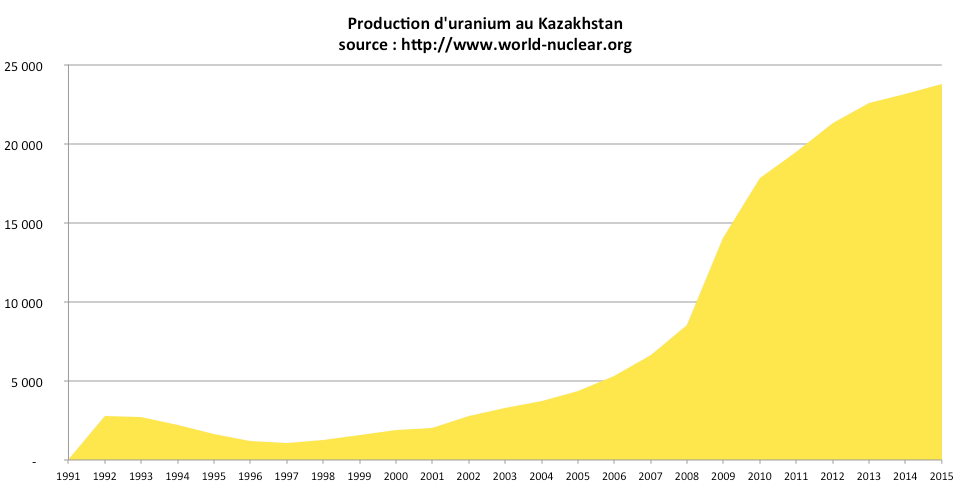Uranium Mining In Kazakhstan on:
[Wikipedia]
[Google]
[Amazon]


Uranium mining
Uranium mining is the process of extraction of uranium ore from the earth. Over 50,000 tons of uranium were produced in 2019. Kazakhstan, Canada, and Australia were the top three uranium producers, respectively, and together account for 68% of w ...
in Kazakhstan
Kazakhstan, officially the Republic of Kazakhstan, is a landlocked country primarily in Central Asia, with a European Kazakhstan, small portion in Eastern Europe. It borders Russia to the Kazakhstan–Russia border, north and west, China to th ...
is of considerable importance to the national economy. By 2011, Kazakhstan was considered to be the world's largest producer of uranium.
History
Uranium exploration in Kazakhstan began in 1943. Later, in 1970, mining began with positive results, leading to more exploration. Some underground mines from the 1950s remain, but are close to depletion. In the past half century, Kazakhstan has been a major source of uranium for the world's nuclear programs. In the decade from 2001 to 2011, Kazakhstan's uranium production increased by 17,428 tons. Kazakhstan has 15% of the world's uranium, and in 2011, Kazakhstan was responsible for 35% of world production. There are 17 uranium mines in the country, however, maximum output is capped at 20,000 tons per year. Currently, 50 deposits are located in six provinces. The responsibility for uranium exploration falls upon two subsidiary organizations of the Ministry of Geology, “Stepgeology” in northern Kazakhstan and “Volkovgeology” in the southern part of the country. Though there is no nationally supported electrical grid, in northern areas of Kazakhstan, electricity comes from Russia, and in the south, Uzbekistan and Kyrgyzstan. China's uranium procurement approach includes investment in foreign mining operations. Chinese investment in Kazakhstan mines have contributed to Kazakhstan's current position as the world's largest exporter of uranium.Companies
Kazatomprom, the nationalized nuclear energy company, was started in 1997. It has oversight of all nuclear activities including mining, exploration, and import/export activities. The company has also formed strong ties with foreign nuclear powers and the company Westinghouse. Agreements are in place with the governments of Russia, Japan, China, Canada, India, and France. Comparing 2010 with 2009, it reported an over forty percent increase in uranium production, and a thirty percent increase in total uranium output.Mines
* Inkai Uranium Project- discovered 1976. 2010 production: 1637 tons * South Inkai mine - began production 2007. expected 2011 production: 1900 tons * Akdala mine - began production: 2006. 2009 production: 1046 tons * Central Mynkuduk mine - began production: 2007. * West Mynkuduk mine - began production: 2006 * East Mynkuduk mine- began production: 2006 * Karatau mine - began production: 2008 * Akbastau mine - began production: 2009 * Zhalpak mine- began production: 2012 * Moinkum mine - began production: 2004 * Tortkuduk mine - began production: 2008 * Kharasan mine- began production: 2005 * Irkol mine - began production:2008 * Zarechnoye mine- began production:2006 * Semyibai mine- began production: 2009See also
* Energy policy of Kazakhstan *Semipalatinsk Test Site
The Semipalatinsk Test Site or Semipalatinsk-21 (; ), also known as "The Polygon", was the primary testing venue for the Soviet Union's nuclear weapons. It is located in Zhanasemey District, Abai Region, Kazakhstan, south of the valley of the Ir ...
*Anti-nuclear movement in Kazakhstan
The anti-nuclear movement in Kazakhstan, commonly known as Nevada-Semipalatinsk (; ), was formed in 1989 and was one of the first major anti-nuclear movements in the former Soviet Union. It was led by author Olzhas Suleimenov and attracted thousa ...
* Kharasan mine
References
{{Europe topic, Uranium mining in Mining in Kazakhstan